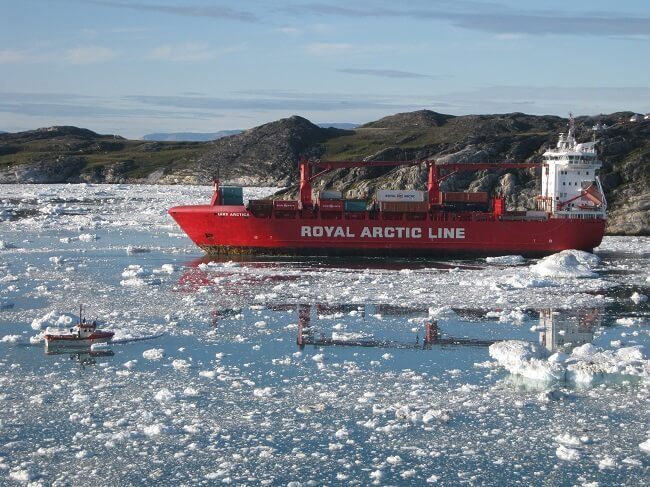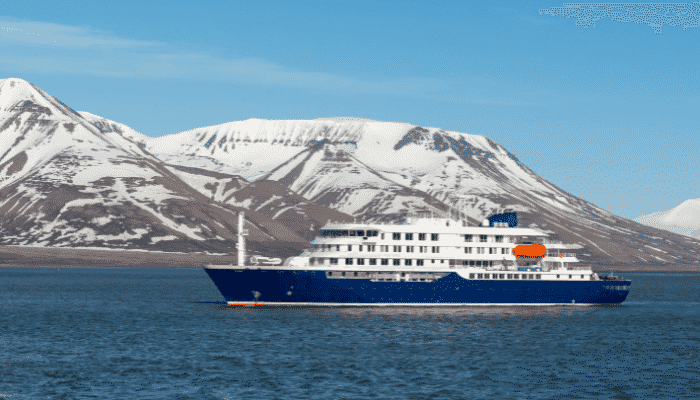How the Ice Melting in the Arctic has Affected the Shipping Industry?
The exceeding ice melting in the Arctic sea has been found and determined by scientific observations over the past few decades, culminating in a record minimum sea ice extent of 4.28 million km2 in 2007 (∼10 million in 1970) (NSIDC, 2007). This melting of the Arctic sea ice has re-ignited interest in efforts to constitute new trade passages, fostering the possibility of economically feasible trans-Arctic shipping as well as greater access to regional resources and spurring development in localized shipping corroborating natural resource extraction and cruising as part of tourism. Although this increased Arctic shipping may render commercial and social development opportunities, the heightened environmental burdens associated are also of high concern.
Effects Arctic Ice Melting on Ship Designs
To comply with the harrowing conditions a new fleet of ships has already been designed for Arctic shipping. Nuclear icebreakers with 16 megawatt reactors and adjustable draft are supposed to help navigate through the thick layered ice packs and even shallow waters to transport the enormous natural resources of oil, gas and minerals out of the Arctic. For example:
Gazprom, the largest oil extractor company has put a 260 meter giant ice-strengthened tanker, which can grind its way through 1.5 meters (5 ft.) thick ice, into service for the Prirazlomnoye oil field.

Lukoil, a rival company has enforced three ships to bring oil to Murmansk from the Varandey offshore terminal in the Arctic.
The modification in design include the transformation from the flattened bows, used to slide onto the surface of the ice and break it open, to a more efficient newly shaped bow by the Phoenix shipping company in Leer, Germany.
Effects on Trans-Arctic Shipping
There were speculations that the drastic melting of the arctic ice would lead to more possibilities for trans-Arctic shipping. Countries like Russia, Canada, the United States (Alaska), Denmark (Greenland), Norway, Sweden, Finland, and Iceland that border the Arctic Circle believe that melting ice at a greater extent means more ships can use Arctic waters. Although this hypothesis formed by conjecturing is not as simple as it sounds.
Arctic shipping can save their respected companies thousands of miles of transit times and fuel costs compared to going around the Horn and through one of the canals but even with the dramatic amounts of ice melting in the Arctic; it is passable for ships only in the short summer and costs a great deal of money to retrofit vessels to sail all the way through icy waters.

As resource extraction businesses have flourished vigorously around the submerged areas of the continental shelf, Arctic shipping has also increased escorted by ice breakers which are utilized for clearing an average depth of about three feet thick ice. Several years of build up ice layers could be around ten feet thick which is most certainly impassable for even the largest ice breaking ships. However nuclear powered ice breakers and also ice rated cargo vessels can get the job done for transporting resources during the summer months.
Ice melting in the Arctic has also set loose ice pieces of various sizes being free of sheet ice or ice cover and is subject to winds and currents while uphold a great depth. Some ships find this loose ice even more difficult than ice sheets to pass through and are sometimes potentially entrapped by the moving ice. The narrow passageways consisting of such ice jams also constitute shallow drafts which consequently limit loads and size of vessels affecting heavily the ship traffic especially for heavily built larger ships which are more appropriate for use in the Arctic.
Effects on Navigation at Sea
Albeit summer is the most preferable time for Arctic shipping, the many navigational problems arising during this time include dense fog and the deficiency of visual contrast between the thick fog and snow cover. Theoretically navigation routes could be identified using the radar navigation system or the global positioning but in practice except for ice survey aircraft or satellites, which are again too expensive for a small amount of traffic, the only way to distinguish ice chunks or ice jams is the visual contact.
Even floating markers cannot be relied upon as they could easily be repositioned by the shifting ice sheets or snagged by ice jams. However with the increased Arctic sea traffic, a few navigational aids like self powered beacons must be considered to be placed on a stable ground for the benefit of the marine pilot to navigate the ship during harsh off season conditions and the continuously changing ecosystem.
Effects on Cruising
Cruising industry can, on the other hand, may exploit this enormous ice melting in the Arctic to its benefit as because, even though facing the same concern as any other sea vessel, cruise ships have this liberty of alternating routes when necessary due to hostile conditions, contrary to the scheduled cargo route. Sightseeing trips are any day more flexible than the cargo ships navigational path. Also for passengers’ safety measures cruising companies has developed this idea of travelling in pair so that in case of entrapment or mechanical failure in one ship, passengers onboard could be transferred to another ship. However this may prove to be difficult to handle and manage as the unstable ground may not allow a second ship to take up a rescue position for a ship to ship cable transfer.

This has led to the use of hardened tenders and enclosed life boats to minimize the risk as more and more individuals are showing interest in visiting the unspoiled natural beauty of the far north as new areas are becoming passable due to the melting of the arctic ice. This is where the cruising companies stimulate and ignite people’s interest for a go-green vacation in the Arctic region; hence there would be a great impact on the cruise-industry.
New Shipping Rule
In order to govern arctic shipping, a few countries are likely to impose shipping laws for the sake of issues of increased access, navigational safety and security and the arctic and global warming. Although reported by Russia, the development of this new policy of Polar Code would inevitably be watched by international organizations like North Atlantic Treaty Organisation (NATO), European Union and the International Maritime Organization (IMO) among others.
Conclusion
Arctic shipping has indeed brought Asia closer to Europe in respect of trading resources. Besides the accessible Northern Sea Route, as a result of ice melting in the Arctic, the changes in the Arctic climate (which is possibly due to global warming) is unblocking the Northwest Passage. Statistics show between the 100 years of 1906 and 2006, only 69 ships had ventured the excruciating voyage through these ice-filled waters for exploring and scientific expeditions, whereas a total of 24 vessels were set sail in 2009 only.
Evidently, the Northern Route through the Arctic is well-suited and one-third shorter than shipping via the Suez Canal in Egypt, thereby the application of Arctic shipping could significantly cut vessels’ emissions of carbon dioxide, apparently reducing global warming. However, research shows that the incomplete combustion of ship fuel, resulting in the emissions of black carbon, deposit on ice and snow consequently and have already contributed to a significant portion of the region’s ice melting.
Do you have info to share with us ? Suggest a correction
Subscribe To Our Newsletters
By subscribing, you agree to our Privacy Policy and may receive occasional deal communications; you can unsubscribe anytime.



